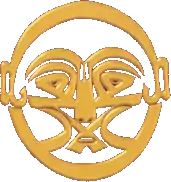Şahkulu
Şahkulu[lower-alpha 1] (Ottoman Turkish: شاه قولو, romanized: Şāh ḳulu, lit. 'servant of shah'; died July 2, 1511), also known as Şahkulu Baba,[lower-alpha 2] or Karabıyıkoğlu[5] (lit. 'son of blackbeard' in Turkish),[8] was the leader of the pro-Shia and pro-Safavid uprising in Anatolia – the Şahkulu Rebellion – directed against the Ottoman Empire in 1511. He was viewed as a Messiah and Prophet by his followers.[9] His death in battle signified the end of the uprising.
Şahkulu Tekeli | |
|---|---|
| Personal | |
| Born | Unknown, |
| Died | c. 1511 Unknown |
| Religion | Islam (Safaviyya) |
| Parents |
|
| Ethnicity | Turkmen[2] |
| Era | Early modern period |
| Known for | Şahkulu rebellion |
| Senior posting | |
| Period in office | 16th century |
Influenced by
| |
| Part of a series on Nizari-Ismāʿīli Batiniyya, Hurufiyya, Kaysanites and Twelver Shī‘ism |
|---|
 |
|
|
Early life
His father was Ḥasan Ḫalīfe, who served Shaykh Haydar, father of Ismail I, that became his representative (halife) to persuade the population of Teke region.[1] Ottoman sources claim Şahkulu was born in a village called Yalınlıköy, modern day Antalya province.[5]
Rebellion
Being inspired by Safavid missionaries, the Turkmens living on Ottoman soil, "as far west as Konya", were mobilized in a "fervent messianic movement", led by Şahkulu.[2] Şahkulu and his followers tried to "replicate" the same type of revolt led by Ismail I several years earlier, "perhaps in anticipation of a union with the Safavids".[2] Şahkulu also worked as the chief of the Royal Ottoman Company of Designers in Istanbul in early 16th century. Him and his army burned sunni mosques and Qurans, raped the natives, killed women and children, and sacked several ottoman towns.[10]
Aftermath
Şahkulu was killed in 1511, and the pro-Safavid movement was "halted temporarily".[2] The Ottomans beheaded and then burned Sahkulu's body.[11] But the anxiety of the Ottomans, in relation to "losing much of their Asian possessions was not eased".[2] Nor did the hatred of the Ottomans for Ismail I cease to exist, even though Ismail apologized for the atrocities caused by the Turkmens and "disowned" Şahkulu.[2] As the possibility existed of a "mass Turkmen exodus into the Safavid realm", Bayezid II sought to establish good relations with Ismail, "at least on the surface, and welcomed Ismail's gestures to establish good neighborly relations".[2] In letters sent to Ismail, Bayezid II addressed Ismail as "heir to the kingdom of Kaykhosrow – the legendary great king of the Shahnameh – and to Dara (Darius) of the ancient Persian Empire".[2] Abbas Amanat adds: "He further advised Ismail to behave royally, preserve his precious and strategically vital kingdom with justice and equanimity, end forced conversions, and leave in peace with his neighbors".[2]
After Şahkulu's followers fled to Iran, Ismail I punished the commanders of Şahkulu, who had killed 500 merchants going from Tabriz to Ottoman territory and pillaged their goods, and divided the followers among his emirs.[6]
Bayezid II had faced a revolt from his own son Selim (who succeeded as Selim I), in the final years of his rule.[2] Unlike his father, Selim, then still a prince, disliked his father's appeasement policies towards the Safavids.[2] When Selim I thus ascended the throne in 1512, things changed drastically.[2] Tensions rose, which eventually led to the Battle of Chaldiran in 1514.
In popular culture
A fictionalized version of Şahkulu appears in the 2011 video game Assassin's Creed: Revelations, where he is called Shahkulu and serves as an antagonist.[12]
He appeared in the board game Assassin's Creed: Arena with Anacletos, Odai Dunqas and Oksana Razin.[13] It was launched on 26 February, 2014.[14]
Notes
References
- H. Erdem Cipa (2017). The Making of Selim: Succession, Legitimacy, and Memory in the Early Modern Ottoman World. pp. 43–44.
- Amanat 2017, p. 52.
- Gibb 1954, p. 128.
- Matthee 1999, p. 19.
- Feridun Emecen. "Şahkulu Baba Tekeli (ö. 917/1511) Antalya bölgesinde büyük bir isyan çıkaran Türkmen babası.". İslâm Ansiklopedisi (in Turkish).
- Ebru Boyar (2012). The Cambridge History of Turkey: Volume 2, The Ottoman Empire as a World Power, 1453–1603. 2. p. 104.
- Jafarian 2012, p. 65.
- Caroline Finkel (2012). Osman's Dream: The Story of the Ottoman Empire 1300-1923. p. 147.
- Finkel, Caroline (July 19, 2012). Osman's Dream: The Story of the Ottoman Empire 1300–1923. Hachette UK. p. 21. ISBN 9781848547858.
- Mikhail, Alan (2020). God's Shadow: Sultan Selim, His Ottoman Empire, and the Making of the Modern World. Liveright. ISBN 978-1631492396.
- Mikhail, Alan (2020). God's Shadow: Sultan Selim, His Ottoman Empire, and the Making of the Modern World. Liveright. ISBN 978-1631492396.
- Converse, Cris (February 6, 2016). "Sequence 7 - Underworld". Assassin's Creed Revelations Game Guide. Booksmango. p. 29. ISBN 9781633235007.
- Delgado, Jesús (February 16, 2014). "Assassin's Creed Arena, el nuevo juego de tablero de AC". Hobby Consolas (in Spanish). Retrieved December 10, 2017.
- Makuch, Eddie (February 14, 2014). "Now there's an Assassin's Creed board game". GameSpot. Retrieved December 10, 2017.
Sources
- Amanat, Abbas (2017). Iran: A Modern History. Yale University Press. ISBN 978-0300231465.CS1 maint: ref=harv (link)
- Bowden, Oliver (2011). Assassin's Creed: Revelations. Penguin UK. p. 52. ISBN 9780141966724.CS1 maint: ref=harv (link)
- Gibb, H.A.R., ed. (1954). The Encyclopaedia of Islam. Brill Archive. ISBN 978-9004060562.CS1 maint: ref=harv (link)
- Jafarian, Rasool (2012). "The Political Relations of Shah Esma'il I with the Mamluk Government (1501–16/907–22)". In Floor, Willem; Herzig, Edmund (eds.). Iran and the World in the Safavid Age. I.B. Tauris. ISBN 978-1780769905.CS1 maint: ref=harv (link)
- Matthee, Rudolph P. (1999). The Politics of Trade in Safavid Iran: Silk for Silver, 1600–1730. Cambridge: Cambridge University Press. p. 120. ISBN 978-0-521-64131-9.CS1 maint: ref=harv (link)